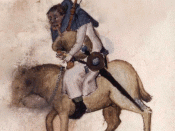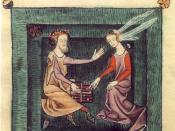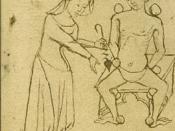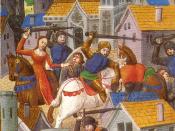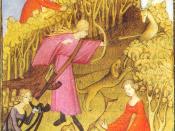Females are portrayed in the Fabliaux as having certain distinct characteristics. In "Les Quatre Sohais Saint-Martin", "The Chevalier Who Made Cunts Talk", and "The Miller's Prologue and Tale" medieval women are portrayed in similar ways. Women are imaginative and therefor their thoughts must be controlled. They also, in the Fabliaux, crave sex and have sexually creative minds. These three Fabliaux texts present women that are similar and represent commonly held views about the female sex of the time.
Women in the Middle Ages were thought of as having wildly creative imaginations. They were capable of much more description and creativity then men. This is portrayed in "Les Quatre Sohais Saint-Martin". The peasant women, when presented with her husbands four wishes, begins to wish for pricks all over her husbands body. After first describing her husband's current state as "soft and like a furry animal" (lecture notes) she goes on to say that she wishes for big pricks, short pricks, curved pricks, strait pricks, and other kinds all over his body including his ears, knees, forehead, and abdomen.
She does not merely wish for one, hard prick but instead lists all the types she can think of. Because the husband only wishes that the "same comes to her" (lecture notes) it is obvious that the wife is the one with the creative imagination. In "The Chevalier Who Made Cunts Talk" the women are also very imaginative. After the Chevalier rescues the three naked women's clothes they decide to each present him with a gift as a reward for acting so honorably. The first grants him a loon. The second grants him the ability to make all cunts speak to him. The third, not wanting to be upstaged by the first and second, gives him the talent to make all assholes speak. It is here that the extents of the female imagination are demonstrated. The Chevalier finds these gifts to be so wild that he thought the girls were mocking him: " 'Those meadow girls made fun of me'" (Guerin 233). In the Middle Ages a woman's imagination was considered a powerful thing that must be controlled. If a woman's thoughts were not controlled there could be drastic consequences like strange characteristics in children. The thoughts and actions of the women in these Fabliaux are representative of this wildly held belief among men.
The women in these three Fabliaux are also very interested in sex. One common idea of the time was that women are dry and need sex and the moisture of a man to replenish them. In "Les Quatre Sohais Saint-Martin" the peasant woman immediately wishes for working pricks on her husband's body. She does not wish for a better station in life, for wealth, good looks, or even for good health. Her first priority is her sexual appetite. Her husband is the voice of reason before she makes her wish. He knows that her wish will be sexual and he tells her they must consider all things carefully. She pays no heed to this warning and makes her sexual wish any way. This Fabliaux illustrates the thought that women were incapable of being rational, possibly because of their highly active imaginations, and that they had, in this case, sex on the brain.
Again, in "The Chevalier Who Made Cunts Talk" the women are representative of Middle Age ideas about women and sex. Two of the three naked women grant the Chevalier sexual gifts. They do not, as one might expect, give him practical gifts like money or long life, but instead they assume that their sexual gifts are the greatest they could give. The Chevalier is dumbstruck and angry at first by their gifts, but later realizes that they are beneficial. When he arrives at court, he discovers he can extract information from talkative cunts, and also that he can make money for himself by wagering on his ability to do this. When the countess wagers with him about this, she again demonstrates the imaginativeness of women by stuffing her vagina with cotton to render it unable to speak. The countess does, however, lose the bet as the Chevalier speaks to her asshole instead. Again the idea of women as sexual creatures is demonstrated by the gifts of the women and the countess' actions.
In "The Miller's Prologue and Tale" the female character Alison is also very interested in sex. She works in cohorts with Nicholas to fool her husband John so she can engage in sexual intimacy with Nicholas: "Doun of the ladder stalketh Nicholay, And Alisoun, ful softe adoun she speddeâ¦Ther-as the carpenter wont to lyeâ¦And thus lyth Alison and Nicholas in bisiness of mirthe and solas" (88). Alison does not uphold her marital vows and if fact works against her husband in trickery to make her indiscretions easier. She also displays her sexual mindset when she places her backside out of the window for Absolon to kiss.
What is interesting about these Fabliaux is the fact that they offer no explanation for the women's sexual desires. It cannot be because they enjoy sex since that was considered evil in medieval times. The peasant woman's sexual wish in "Les Quatre Sohais Saint-Martin" can be explained by the fact that she is a peasant and therefor very close to the animals and animal desire. As to the naked women in "The Chevalier Who Made Cunts Talk", the Chevalier later says that they must be nymphs and not really human. Alison in "The Miller's Prologue and Tale" might have sex with Nicholas because her husband John is old and unable and she needs to replenish her dry body.
Whatever the reason behind these women's sexual desires, they are still presented in the three Fabliaux. Women are also represented as being very imaginative and creative in the texts. While these are three very different works with different plots and characters, the themes about women remain the same in all of them, and reflect the common views of women held, by men, at the time.
